eComm conference 2009
Last week I participated in the eComm conference (The Emerging Communications (eComm) Conference & Awards) in Amsterdam. Impressions? I’m impressed. For two reasons.
Firstly, I was impressed by the conference itself.
Reason 1
The organization was excellent. Moderation by Lee Dryburgh kept both speakers and audience (during question rounds) within strict time constraints. Content-wise the event was engaging and informative. Westergasfabriek proved to be a great venue. Big enough to have sitting places for every single participant and small enough to feel cozy and enhance socializing during breaks.
I wasn’t very convinced about the idea of packing 5 days’ worth of conference into only 3 days. I of course understand time constraints issues and increased costs for spreading the content over more days but it indeed turned out to be a “contest of attention”, as Lee joked. Starting at 8:30AM with a morning coffee and finishing at 6PM, the conference seemed like a “stay awake and concentrate” marathon. The tight schedule collided with my university and work obligations so I couldn’t make it to all the speeches. But of course the event was organized for telecom professionals who came to Amsterdam to receive as much information during the least time possible (or so I imagine it) and not for busy students.
I was also impressed by the extensive use of Google Wave during the event. All the participants had received an invite a couple of days before eComm and the new accounts were put into good use! It was my first interaction with the platform and I must admit that it proved perfect for such situations. I’m not sure how often I will use this technology in my every-day online communication but I see a great potential in it. Google Wave is a communication and collaboration tool which merges e-mails, instant messaging, wikis and social networking. A great instruction video from Google might make it easier for you to imagine how it all works, in case you haven’t tried waving yet:
A total of 71 waves were created during eComm and they made it easier to follow the presentations. Some speakers uploaded slides from their presentations and most included at least outlines of what was being said.
A separate wave was created for the discussion of… the quality of catering! The lunch was indeed nice. Fresh fruit and even soy milk were available during breaks. But enough with the general remarks. I’d like to discuss some of my favouring speeches.
Day 1
Alexandra Deschamps-Sonsino from tinker.it talked very interestingly about How the “Internet of Things” will Change the Way we Connect. The idea that we can become one with our environment was nicely illustrated by vast examples:
Kill-a-Watt (allows you to connect your appliances and assess how efficient they are), Kickbee (belt which sends tweets every time your baby kicks), CATaLOG (RFID cat tracker) or botanicalls (opens a new channel of communication between plants and humans, in an effort to promote successful inter-species understanding) are some interesting examples.
My presentation-of-the day was How the Mobile Phone is Changing your Reality Forever by Claire Boonstra who presented some impressive facts about Layar, a virtual reality browser. Apparently Samsung Galaxy comes with a pre-installed Layar in it and about 180 layers are available worldwide. 3D versions are planned to be made available online soon, so stay tuned.
Day 2
Thursday was much more technical than the previous day. The highlight of the day for me was a presentation by Skype’s Sten Tamkivi. He discussed whether Skype can be equalled to telecoms and concluded that in fact, no. Skype is, in his argument, not pulling clients away from telecoms but is creating a new traffic, generating minutes which would never have happened otherwise. Reasons mainly being high costs of lengthy calls. Tamkivi claims that 500,000,000 hours of calls from the USA to Mexico were made through Skype, the number probably being significantly smaller if people had to pay for those hours.
The speech ended strongly – Tamkivi concluded with the following statistics:
“In the last 30 minutes (the length of the presentation):
100,000 hours of Skype-to-Skype calls were made
33,000 video calls on Skype were made
12,000 Skype calls to landlines and mobiles were made”
For a more extensive discussion of the presentation, read John’s post Paranoid of the Proprietary: To Skype or Not to Skype on the Masters of Media blog.
Day 3
Friday started off strongly: the Google Wave team presented their new product. It was interesting and heavily waved about. Next, Stefan Agamanolis (Distance Lab) presented a very engaging concept of “slow communication” (as opposed to “fast communication”, yes similar differences as in the case of slow and fast food). Distance Lab makes us rethink the way we communicate. Often not concentrated enough on the conversation, as we multitask. Isophone takes conversation to another level:
Isophone is a sensory-less device. Floating on the surface of water you are deprived of any outside distractions. You are exposed solely to the other person’s voice, as no other sense is involved. You don’t touch anything, don’t smell anything, don’t look at anything, don’t feel anything. Apparently people have reported to be more creative while talking on the isophone. BBC wrote an interesting article about the device. This was my favourite presentation of the day, I found most of the other presentations to be too technical for me. I couldn’t stay until the end but nevertheless, I was very happy to have participated.
Reason 2
Participating in the conference made me realize that the New Media master is teaching me even more than I had though it was teaching me. To my surprise, we discussed so many concepts brought up at the eComm in our class. It is very nice to see that my knowledge comes from the real world.
Two thumbs up. For both the eComm and New Media master.
If it’s not on Wikipedia, it doesn’t exist
Florian Brody is an internationally acclaimed digital media specialist with more than twenty years experience in electronic publishing in Europe and the U.S. He is the President of Brody Inc., a publishing company based in Los Angeles and Vienna that is dedicated to the emerging information society. With a background in linguistics and computer science, He teaches at Vienna University and Art Center College of Design. (1, page.xi)
According to his personal webpage, “Florian has been instrumental in developing groundbreaking media solutions and communication strategies for Fortune 500 companies, including Kodak, Apple and Accenture. Florian co-invented Voyager’s Expanded Books, the first electronic books to be read on a laptop, in 1991. (…) Florian studied Computer Science and Linguistics at the University of Vienna and worked as researcher in computer linguistics and film theory. (…) He frequently keynotes at events and is published in the field of digital media and electronic publishing.” (2)
In his 1999 article The Medium is the Memory, published as a chapter of The Digital Dialectic. New Essays on New Media, Florian Brody analyzes human development from the perspective of memory set in pure orality (ancient times) to machine-enhanced memory (modernity). Long gone are the times when knowledge was passed from mouth to mouth. Long gone are the times when monks in the Middle Ages caligraphed each separate edition manually. Even long gone are the times when a family could rarely afford more books than a single edition of the Bible. „The book has always been used in personal ways, as an extension of memory“ (3, p.2), „Between the covers lies a promise: the possession of a book will mystically extend the mind of the owner“ (4, p.3), „The book is a personal item, an extension of an individual’s memory” (5, p. 3). As with all “new media”, with the development of the moving image it had been widely argued that the rise of films will cause the demise of books. In the case of new computer-based media Brody argues that, unlike film, the digital media have the potential to emerge as a new type of book – “a memory machine in and of itself”.
The Memory Theatre, a concept used by Giulio Camillio, Giordano Bruno and later by the English hermetic philosopher Robert Fludd, was a theatre that would contain all the concepts and the knowledge of the world. By entering the theater, one would gain access to that knowledge and be able to grasp the concepts contained. The theatre was seen reversed – the information was set up in the auditorium and the user/reader was set on the stage, where he observed from him central position all the aspects presented to him: everything in the world, everything above and everything below. Later, the book becomes our memory theater. (6, p.7)
I read this and I instantly think about Kevin Kelly’s speech at the 2007 EG conference:
A computer connected to the Internet Internet IS the Memory Theatre! The amounts of information available online are vast and the growth of the Internet seems to be exponential. Kevin Kelly presented his statistics in 2007 and already then, after only 5,000 days of the Internet’s functioning, it was compared to the one of human brain.
Richard Koenigsberg comments on the video:
Sep 7 2009: Extremely interesting video. We are involved in a revolution. Without embracing the mystical dimension, what is clear is that the Web becomes a conduit for the thinking of the human race. Where does knowledge exist? It used to be that we identified libraries as the place of knowledge. Or bookstores. But am I really going to wander around the New York University library as I once did? The Web provides a center that contains all the knowledge one needs(…). (7)
Even university libraries offer access to their catalogues from home. In his book Planet Google: One Company’s Audacious Plan to Organize Everything We Know Randall Stross draws a very suggestive image of Google’s ambitions. The recent Google Wave tool will help Google access a lot of our personal data, while Google Books already offers access to huge amounts of copyrighted content (8). This was still not the case in 1999 when Brody wrote his article. Wikipedia was only launched in 2001 and the first public offering of Google’s search engine took place in 2004.
„It strikes me that we are in the midst of returning to a medieval model: deaccessioning our large scale personal libraries, unifying all our texts in the one place: the computer” (9, p.3). Writing this in the 90’s Brody couldn’t have known just how popular the MacBook will become. Our computers have indeed become our personal libraries, calendars, notebooks and in same cases, entire workstations.
In Brody’s eyes interactive multimedia, virtual reality and the Internet are hoped to serve as the ultimate memory machines which will help us to store everything forever: “(…) all knowledge, every story, the punch lines to the totality of human humor, all questions, the sum total of the answers” (10, p. 8). Is this not exactly what is happening right now? The Next Web has published a great iconographic of all of Google’s acquisitions thus far. Click on the link to see it. Industries mentioned stem from technology, web services, search to video, new, mobile, social, imaging and others. Google wants all the world’s information, is this not the case?
„Although text in a computer is far less stable than the written or printed word we assign it a very high truth-value. Early computer pioneer Joseph Weizenbaum of MIT remarked, <<My father used to say, „It is written in the holy books.”>> Today we say, „the computer tells us” (11, p.11). This is very much true. The computer tells us. Or to be more precise, Wikipedia tells us. The computer is the new book. I guess we can all agree with Brody that “The medium is the memory”. Wait, how did the original phrase go? – some of the less-exposed to McLuhan of us might ask. Just google it!
Other publications by Florian Brody:
The Columbia Guide to Digital Publishing: Multimedia Publishing. New York: Columbia University Press, 2003.
Interaction Design. State of the Art and Future Developments. An argument for information design. Rockport Publishers 1998.
Books the Next Generation—Reading on the Electronic Frontier. Heidelberg: Springer,1996.
Tabula Rasa in: Cutting Edge Web Design, Rockport 1998.
My Home is my Memory is my Home. Mediamatic, Amsterdam 1995. (Doors of Perception Conference 2)
References:
1. Brody, F. (1999). The Medium is the Memory In: Lunenfeld Peter (ed). The Digital Dialectic. New Essays on New Media. MIT Press, Cambridge Massachusetts, Brody’s chapter available online: available at: http://www.brody.org/Brody/The_Medium_is_the_Memory__files/Brody_MediumMemory.pdf
2. Florian Brody homepage: http://www.brody.org/Brody/About.html;
3. Brody, F. (1999). The Medium is the Memory In: Lunenfeld Peter (ed). The Digital Dialectic. New Essays on New Media. MIT Press, Cambridge Massachusetts;
4. Ibid;
5. Ibid;
6. Ibid;
7. Richard Koenigsberg (2007), comment: http://www.ted.com/talks/lang/eng/kevin_kelly_on_the_next_5_000_days_of_the_web.html;
8. Randall Stross (2008), Planet Google: One Company’s Audacious Plan to Organize Everything We Know . Free Press;
9. Brody, F. (1999). The Medium is the Memory In: Lunenfeld Peter (ed). The Digital Dialectic. New Essays on New Media. MIT Press, Cambridge Massachusetts;
10. Ibid;
11. Ibid.
“I’ve had the best breakfast ever” – say it using 14, 140 and 1400 symbols
Phatic communication is a term first used by anthropologist Bronisław Malinowski to describe a communicative gesture that does not inform or exchange any meaningful information or facts about the world. Its purpose is a social one, to express sociability and maintain connections or bonds. We can call it small talk.
Are words in Phatic Communion used primarily to convey meaning, the meaning which is symbolically theirs? Certainly not! They fulfil a social function, and that is their principal aim, but they are neither the result of intellectual reflection, nor do they necessarily arouse reflection in the listener. Once again we may say that language does not function here as a means of transmission of thought. (1)
Phatic messages are not intended to carry information or substance for the receiver, they concern the process of communication. The fact of saying something is more important than what exactly is being told. They are meant to establish an atmosphere or maintain social contact rather than convey content. Examples of such phatic communications include courtesy titles in letters (“sincerely yours”, “all the best”), inquires about health or weather and a simple “how’s it going?”. (2)
With the enlargement of our social networks caused by greater connectedness we require the means to maintain sociability without spending too much time on it. The receivers of our messages do not necessarily need to be provided with “true” content. Sometimes an interesting link in a person’s status with a short comment can be more desired than an elaborate update on their daily lives. With such platforms as Facebook, private communication can be executed by the means of “private messages” while phatic communication can take place on the “wall” and through “status updates”. Platforms such as twitter provide solely for the need of phatic communication, enabling no private exchanges and limiting users to 140 symbols for status updates. Those small communicative gestures are not meant for exchanging meaningful information but for expressing sociability and maintaining interpersonal connections.
According to Vincent Miller it should not be assumed that “these phatic communications are ‘meaningless’, in fact, in many ways they are very meaningful, and imply the recognition, intimacy and sociability in which a strong sense of community is founded. Phatic messages potentially carry a lot more weight to them than the content itself suggests. However, although they may not always be ‘meaningless’, they are almost always content-less in any substantive sense. The overall result is that in phatic media culture, content is not king, but ‘keeping in touch’ is.” (3). In this spirit we can assume that the point of twitter is the maintenance of connected presence and sustainability of this presence, even though it is almost completely devoid of substantive content. The medium of twitter encourages the “disconnectedness” of communication. The above-mentioned 160 character limit and lack of private messages promote generic ‘announcements’ over dialogue or targeted conversation.
In the spirit of Marshall McLuhan we could even assert that when it comes to such electronic media as twitter or Facebook, “the user is the content”, as our phatic communication is a perfect source the marketing industry’s data mining. The shortness and density of communication enables for creating databases and key word searches. Lev Manovich argues that we are in the process of a shift from narrative forms (as novel/film) as the key form of cultural expression, to the database as the prominent cultural logic of the digital age. Narratives, he argues, are finite works with beginnings and endings. They can be also characterized by following a linear path which establishes cause and effect determined by an author. Databases, on the other hand, are “structured collections of data organized for fast search and retrieval by a computer” (4). Following this logic Miller concludes that:
“The movement from blogging, to social networking, to microblogging demonstrates the simultaneous movements away from communities, narratives, substantive communication, and towards networks, databases and phatic communion.” (5)
Manovich fits in perfectly within this observation, as he states that new media is dominated by cultural objects and products which:
“do not tell stories, they do not have a beginning or end, in fact, they do not have any development thematically that would organize their elements into a sequence. Instead, they are collections of individual items, with every item possessing the same significance as any other.” (6 )
This is essentially what twitter is all about – individual items, with every item possessing the same significance as any other. But if twitter helps us realize our needs for phatic communication while providing us with such a limited platform, what would you say about a 14 characters limit? Playing on twitter’s question: “what are you doing right now?” squeaker lets you tell your friends “what RU doing right now”. The authors hint you towards the possible uses of the platform:
What can you accomplish in 14 characters?
- – u cn use abbrs
- – no room 4links
- – … b creative

Squeaker is obviously meant as a parody of twitter. Join The Company, LLC. are the people behind both squeker and woofer. In case you hate small talk and don’t perceive being asked “how’s it going” (which is usually followed by the inquirer walking away without even waiting for your answer), you can shift to the latter platform. Woofer, while still playing on the concept of phatic communication, let’s you express yourself within… a minimum of 1400 characters. Join The Company, LLC. are not the only ones to parody twitter. If twitter is a microblogging site then woofer is a macroblogging site, while squeaker and flutter would be called nanoblogging sites. Flutter is an evil twin of twitter, enabling you to express yourself within the limit of 26 characters. “Let’s say my friend tweets something, like working on some new designs for the album cover and watching project runway in my underwear lol!” – the employee of fictional flutter explains that such a message could be automatically shortened by the site to “wrking 4 project underwear”. The joke mocumentary was created by the Slate Magazine to poke fun at our addiction to microblogging and the resulting shallowness of communication.
As with everything, it’s all about balance. I’m not a twitter user and I don’t really see where exactly its charm lies but I’m convinced it’s got to be somewhere out there. And I really don’t see anything harmful in a little small talk and announcing who had what for breakfast, as long as there are people who want to read about it. Phatic communication has been with us since the dawn of human kind. It might not be full of content but sometimes it’s nice to throw a solitary “man, the weather sucks”. Especially when you live in Amsterdam, where it seems to rain all the time.
References:
1. Malinowski, B. (1923) ‘Supplement 1: The Problem of Meaning in Primitive Languages’, in C. Ogden and I. Richards (eds) The Meaning of Meaning, pp. 296–336. London: Routledge & Keegan Paul. p. 315
2. Miller, V. (2008). New Media, Networking and Phatic Culture. Convergence: The International Journal of Research into New Media Technologies. 2008; 14; 387
3. Ibid.
4. Manovich, L. (2001) The Language of New Media. Cambridge, MA and London: MIT Press. p. 218
5. Miller, V. (2008). New Media, Networking and Phatic Culture. Convergence: The International Journal of Research into New Media Technologies. 2008; 14; 387, p. 396
6. Manovich, L. (2001) The Language of New Media. Cambridge, MA and London: MIT Press. p. 218, p. 213
Become a Fan: Facebook marketing
Facebook is smart. And they certainly are not a charity sale. In order to provide the thousands of employees with the great benefits and to keep on growing they’ll annoy their users just enough to make some money, but not enough that they migrate to The Next Big Thing. Facebook advertising is not all that obstructive. Even when ads do show up, they are nicely related to your own interest. How does Facebook know how to target you? Because of all the information you give them voluntarily. Advertisers can target you by location, age, gender, education, workplace, relationship status, relationship interests, languages and of course – keywords (Facebook Advertising). A Miami-based wedding planning company can set their campaign to run only on users‘ accounts who live in Miami or within a certain range of kilometers away from it and who set their relationship status to „engaged“. Facebook can help you out with designing the optimal campaign (Suggested Best Practices for Advertising on Facebook). Facebook even prepared “The Insider’s Guide to Viral Marketing“, a document which describes various viral marketing practices available on the site.
As well-designed as Facebook marketing can be, we all know that we don’t like adverts, even if they match our interest. Facebook has a solution for this too – Fan Pages. These are corporate pages which can be set by official business representatives of a company or an organization.
“Create a Page for My Business” – guidelines.
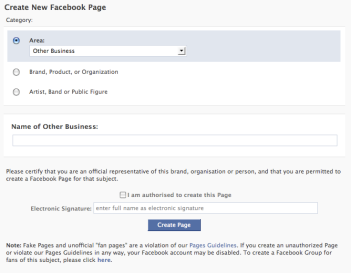
In this post I would like to research various examples of on-obstructive, opt-in marketing techniques are used by companies on Facebook. Brands can create a great space for their costumers to engage with the product. Solutions are vast: create an application, poll, put your videos (commercials) online, create events, write notes, update your status, create incentives for joining your community. The keyword is “opt-in” – users decide themselves that they want to engage with the brand, as opposed to being bombarded with messages they do not want to receive. Let me illustrate this claim with three examples, showing how brands can take full advantage of creating a consumer space on Facebook for marketing purposes:
Case Study 1 – Ben&Jerry’s (Fan Page)
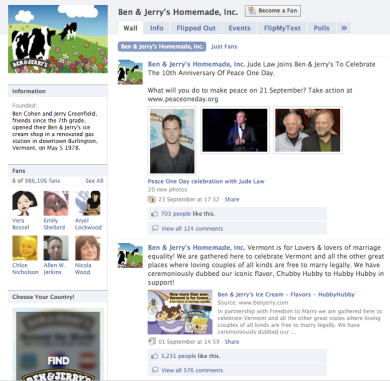
Let’s examine how Ben&Jerry’s is utilizing Facebook as a marketing platform.
To celebrate the launch of Ben&Jerry’s Flipped Out ice cream the company partnered with FlipMyText to let you surprise your friends with a flipped out status (which hopefully mentions how amazing Ben&Jerry’s is).
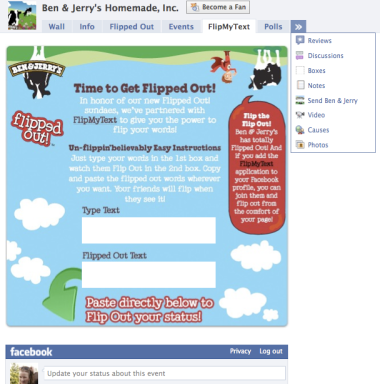
On this note I would like to draw your attention to how many interaction options the company’s Fan Page enables: next to the usual “Wall”, “Info”, “Reviews”, “Discussions”, “Boxes”, “Notes”, “Video” and “Photos” there is also information about the new product (“Flipped Out”), “Events”, “FlipMyText” utility, “Polls” (“How do you like your ice cream?”, “Your favorite Flipped Out flavour?”), “Send Ben&Jerry” and “Causes”.
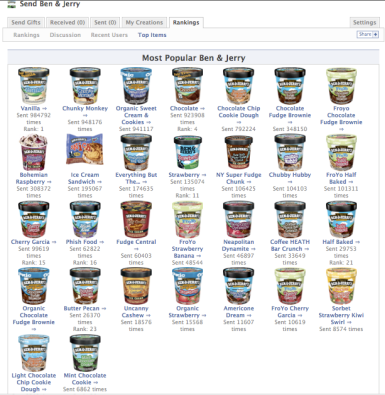
“Send Ben&Jerry” not only plays on the functionality of sending your Facebook friends gifts but also promotes the variety of flavours.
Result? The producer of delicious ice cream has managed to gather quite a fan base on Facebook: 986,077 people state their support for the company. Many of them are actively engaged with the Page:

When Ben&Jerry announced a temporary name change for its popular Chubby Hubby (to Hubby Hubby) in order to celebrate legalization of gay marriage in Vermont, 3.231 people “liked” the information and a stunning 576 of them left a comment to praise the move. An active community who are engaged with the brand for a prolonged period of time voluntarily and without a material incentive are all a brand can ask for… It takes a great product to create such a bond, but creating a platform for the brand’s supporters to unite is equally important.
Case Study 2 – Burger King „Whooper Sacrifice“ (Application/Fan Page)

What was announced by the press to be one of the most creative advertising campaigns on Facebook (Tech Crunch) was shut down (or rather disabled, as it still exists only its functionality is blocked) just a week before its launch. „Whooper Sacrifice“ was Crispin Porter + Bogusky creative ad agency’s campaign for Burger King. You get rid of 10 friends from your friends list, we give you a free Whooper voucher. 233,906 friends were removed by 82,771 people in less than a week. The reason for the shut down was privacy issues violation:
„ We encourage creativity from developers and brands using Facebook Platform, but we also must ensure that applications follow users’ expectations of privacy. This application facilitated activity that ran counter to user privacy by notifying people when a user removes a friend. We have reached out to the developer with suggested solutions. In the meantime, we are taking the necessary steps to assure the trust users have established on Facebook is maintained.” (1)
What the Facebook team didn’t like was the generation of a news feed about being deleted from somebody’s friends list. Usually, when somebody is deleted by another user no notification is shown to either the person or the person’s friends. Reactions of the public ranged from shock of how anti-social the application was, to extremely enthusiastic. In the end, what really mattered was the vast media coverage the campaign received, creating a lot of free media buzz. Possibilities offered by Facebook as a marketing platform were used creatively and to a full extend.
By the way, check out the Subservient Chicken campaign.
Case Study 3 – Heyah (Fan Page)
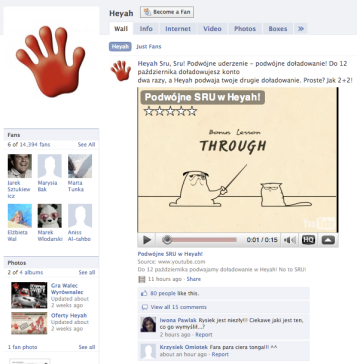
Heyah is a pay-as-you-go brand offered by Polish GSM provider Polska Telefonia Cyfrowa, targeted mainly at young people. It’s Facebook existence in the Pages section has attracted 14,394 fans who are a very active community. The brand is known for its excellent marketing campaigns and takes full advantage of what the Facebook marketing platform has to offer as well.
One of the most successful recent marketing campaigns in Poland was Heyah’s “No To Sru”. The ad used a play on the English word “through” the the Polish common mispronunciation thereof – “sru”. The colloquial word “sru” can be loosely translated as “down with it”. When the cat-student gets annoyed by the dog-teacher he nonchalantly says what can be translated as: “Whatever. Down with it”. He then drops the iron anchor on the dog and the lector mentions all of Heyah’s services which are “down in price”.
Hayah’s Facebook fan has an easy access to all of Heyah’s recent commercials within one click. “No To Sru” has become the most popular animation film on YouTube amongst Polish people. Heyah has even made space for fan videos:
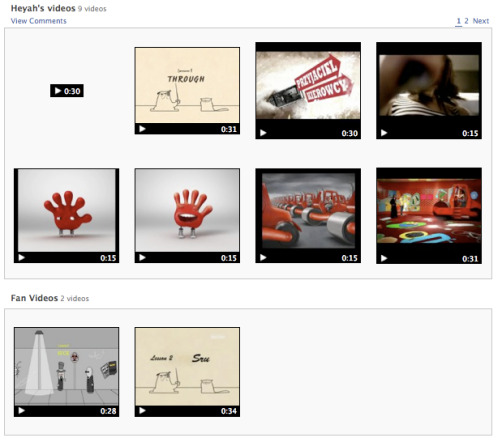
An application has been created which enables the users to create their own scenario of the commercial. One can use various cat and dog figures, text bubbles and props. A funny example of fan art:
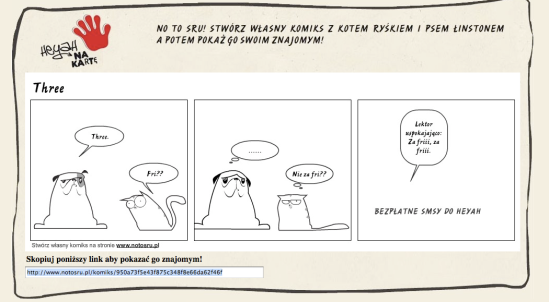 Frame 1.
Frame 1.
teacher: Three
student: Fri (common Polish pronounciation)
Frame 2.
teacher: ….
student: Not for free (fri)?
Frame 3.
Lector in a calming voice: for free, for free… (Free SMSes within Heyah)
Heyah also makes sure to not only interact with its “fans” but also to promote its products through the Facebook platform:
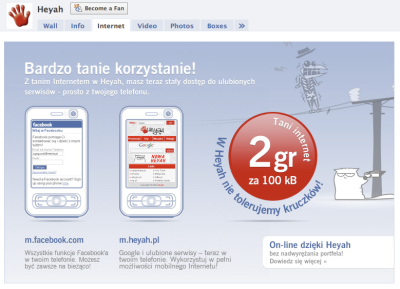
On the Fan Page one can find a poll (168 likes, 111 comments) and Heyah ringtone (149 likes, 28 comments). The company tries to stay close to the consumer base. One of its status updates reads: “We have 10.000 fans. Thank you!” (111 likes, 36 comments).
Conclusion
Such an intimate way of consumer-brand interaction was not possible in the pre-Web 2.0 world. Companies are smart to realize the potential of the opt-in marketing on social platforms such as Facebook. Maintaining a company’s positive image is an essential part of promotional strategies and Facebook is a very good place to promote oneself. Simply starting a Fan Page might not be enough, however. Ben&Jerry’s, Burger King and Heyah seem to understand that it is important to create extra value for members to join in. Providing them with interaction, additional features and sense of community strongly enhances their online company experience and can strengthen the consumer-brand bonds.
References:
1. Brian Morrissey (2009). BK Offers Facebook ‘Sacrifice’. AdWeek.com: http://www.adweek.com/aw/content_display/news/digital/e3i9953839003c11ce8bbf5f762069ef9ba
Book review: UBERMORGEN.COM
UBERMORGEN.COM might be always trying to combine some nice entertainment with very intellectual European subversive art, but God Christ, we need to relax sometime and sell Google ad space on eBay and write a book about it and sell that on Amazon and twitter everybody about it and be totally modern, postmodern and lostmodern 1.
The book UBERMORGEN.COM is a two-part art catalogue documenting all of the projects conduced by Hans Bernhard  and lizvlx,
and lizvlx,  founders and main activists of the UBERMORGEN.COM group. Vastly illustrated and providing much informative material, the book is an excellent read. Despite my biggest effort I couldn’t find a book cover picture online, my apologies.
founders and main activists of the UBERMORGEN.COM group. Vastly illustrated and providing much informative material, the book is an excellent read. Despite my biggest effort I couldn’t find a book cover picture online, my apologies.
After examining the projects carried out by UBERMORGEN.COM readers should not be at all surprised to find: psychological complexity (bipolar disorder syndrome), videogames of the 80’s, use of recreational/medical drugs and interpretation of the screen as an infinite space amongst Bernhard’s main influences. The art duo seems to be taking their audience on a psychodelic trip into the altered reality of digital present and digital fantasy future, and we’re all in for a ride.
No answers, just questions
You might recognize Hans Bernhard (YouTube channel/blog) as the historic net art pioneer who was involved with the legendary group etoy2. The anti-corporative rhetoric of etoy can be seen reflected in the nature of UBERMORGEN.COM’s projects. They can be described as dystopian, as no redeeming light can be seen on the horizon of their undertakings and most of them have an anarchist feel. Corporative methods and propaganda are systematically adopted and deconstructed, as UBERMORGEN.COM create mostly politically intertwined art. However, they don’t engage in a dialogue, rather simply throwing statements at confused audience („all of UBERMORGEN.COM’s work […] offers no answers, just raises questions“3. I suppose this is what makes them artists, as opposed to political activists.
It’s Absolutely Different Because It’s Fundamentally Different
The most powerful art project ([V]ote-Auction) cost the collective 70.000 Euro in legal fees and a ban to ever enter the territory of the United States. What is especially impressive of UBERMORGEN.COM’s debut work is that it caused enough panic for CNN to broadcast a half hour programme on the project.
You can watch the video here.
Set-up just before the US presidential elections, the website http://www.voteauction.com declared its desire to „bring capitalism and democracy closer“ by enabling American citizens to sell their votes to whoever would like to pay the most. The site further explained: „Voteauction.com […] is now owned by an Austrian holding company that has invested in many of America’s new, emerging industries. We feel that the American Election Industry provides unique new opportunities for the foreign investor. We purchased voteauction.com in order to investigate the profit-making potential of the American Election Industry“4. Media outburst caused UBERMORGEN.COM to answer an average of 30 telephone and 15 email interviews per day.
In reality it was indeed solely an art project and not a business endeavour. All statistical data (e.g. price per vote) was phony and no one could actually buy or sell their votes. The website was designed more as an aesthetic forum for rethinking democracy rather than anything else. UBERMORGEN.COM refused to engage in a political dialogue condemning or protesting against political art or activism.
Asked by CNN reporter Van Sustern about the difference between lobbying politicians and selling votes, William Wood, Chief Counsel of state of California, said „It’s absolutely different because it’s fundamentally different“. UBERMORGEN.COM use this pearl of wisdom as their slogan for [V]ote-Auction.

Perfectly (dys)functional installations
Alessandro Ludovico, a media critic and editor in chief of the highly respected Neural magazine, provides the readers with a very interesting Introduction to the main book of the set. He states that:
„Most of UBERMORGEN.COM’s installations show something plausible, tangible and perfectly (dys)functional, which has apparently been (unlawfully) appropriated from a future that is just around the corner. These objects are not really prototypes, but complex abstractions that seem to have arrived ahead of their time in their social and/or economic setting. UBERMORGEN’s anomaly is here to make a difference in how we perceive „reality“ – now and at least until the day after tomorrow“ 5 (UBERMORGEN meaning tomorrow or the day after tomorrow in German).
This is a very good observation. Projects described in this book are too plentiful to be all discussed in detail but let’s take a look at some of those (dys)functional installations.
Foriginal media hacks
Generator Tetralogy projects were mostly inspired by the legal outburst accompanying the [V]ote-Auction project: domains being shut down, legal fees to be paid and a lot of legal correspondence being sent by email.
All of the four generators create [f]originals (forged originals) – prescriptions (Psych | OS Generator), court orders (IP NIC – Injunction Generator), bank statements (BANKSTATEMENTGENERATOR), and torture protocols (Superenhanced Generator). The term [f]original is used to describe „any document or legal paper that in the narrow sense of the word is not an original any more, as it has been generated by a machine (…) and is „valid without a signature“. (…) [F]originals claim authenticity but on closer inspection they turn out to be the product of „consensual hallucination“) 6. Again, the generators leave the audience with no commentary but we can already deduce what the artists are trying to tell us. They came up with a creative reaction to running into a lot of legal and financial inconveniences during the [V]ote-Auction project. Even though emailed documents aren’t legally considered official UBERMORGEN.COM had to bear the burden of consequences. As a response they created a series of generators capable of forging different types of documents usually issued only by professionals, just as in their opinion emailed documents are forgery.
EKMRZ Trilogy
The trilogy deals with e-commerce and uses the dialectics of Google (GWEI – Google Will Eat Itself), Amazon (Amazon Noir – The Big Book Crime) and eBay (The Sound of eBay). Allegedly admiring and being attracted to those websites, UBERMORGEN.COM (ab)use them in very interesting ways.
GWEI – Google Will Eat Itself project uses the AdSense mechanism. Every time a user clicks on one of the GWEI-networked sites, UBERMORGEN.COM receive money from Google. Then, they use the money to buy shares of Google itself. It is estimated that it will take 202.345.117 years until GWEI fully owns Google.
Amazon Noir – The Big Book Crime uses the „Search Inside the Book“ mechanism to decode the full content of a book. A sophisticated robot-perversion-technology accesses the books using different identities, copies contents of each page and reassembles the book automatically into a single PDF file. Then the book is shared through peer-to-peer networks.
The Sound of eBay generates unique songs by using eBay user data (credit card information, bank details, password, bought and sold items, prices, ratings, comments, etc.). The songs are presented in teletext porn style.
Double trouble
I would most definitely recommend this book to anyone interested in digital media art, especially if the person leans slightly towards anti-consumerism or maybe even anarchism. Plenty more projects are described in the book and due to length constraints weren’t mentioned in this article. I would definitely say that they surely are interesting to read about and can provide substantial amount of entertainment, some possibly only to those with indiscriminate taste. I enjoyed learning about each and every single of the projects.
Just to give you an example of what else can be found in the book:
– Webpaintings. An Internet site which looks like a website but has no functionality and therefore exists only as a painting. Some examples from the gallery: THE_WHITE_WEBSITE, THE_BLACK_WEBSITE, AnuScan Inc.
– Chinese Gold. A project about Chinese „Gold Farmers“ – teenagers who are employed in digital sweatshops to play online games such as World of Warcraft. They produce in-game currency, equipment and characters which are later sold by the companies to American and European gamers via eBay.
– Numerous other projects (e.g. Nazi Line, Wahlgeld.com).
The double feature of the book leaves me a little puzzled. It seems that the main book consists mainly of media material describing each project, while the accompanying book functions as artists‘ commentary on the projects. I find this division slightly confusing. If the reader wants to grasp information about a specific installation, they have to browse through two separate books, chapters of which are not coordinated. Not only are they not coordinated but also the accompanying book doesn’t contain information about all of the projects – just a selection.
Another issue that I found slightly bothersome is the unequal division of attention dedicated to each project. While some chapters contain vast amount of materials, Plasticman – Role Model provides the readers solely with a poem, pictures and information that it is „a collaboration between UBERMORGEN.COM and scandinavian porn producer & photographer Petter Hegre“ 7. I am left with a feeling of inefficiency.
Editing of the book also leaves a great deal to be desired. It should be decided once and for all is names and countries are to be spelled with capital letter (preferably yes, but if small case has to be used I would prefer to see this pattern equalized throughout the whole book).
Those complaints are only minor in my judgement, as the overall content of the book left me wanting to read it cover-to-cover. A nice bonus for those especially curious can be found at the back of each book – quite a big selection of texts written about UBERMORGEN.COM by various journalists and numerous exhibition pictures (main book).
Footnotes:
1. Domenico Quaranta „It’s lustful entertainment, baby! Interview with UBERMORGEN.COM“, in Digimag, Issue 39, November 2008
2. Piotrowska Hania “Etoy vs. Etoys – Toywars”, in Logo and Image blog, Maastricht University, 14 May 2007
3. Ubermorgen.com “Psych|OS Generator”, in Ubermorgen.com, fpeditions, 2009, p.42
4. Ubermorgen.com “[V]ote-Auction”, in Ubermorgen.com, fpeditions, 2009, p.5
5. Alessandro Ludovico “UBERMORGEN’s anomalous contemporaneity”, in “UM.“, Christoph Merian Verlag, 2009, p.7
6. Ubermorgen.com “Foriginal Media Hacks”, in Ubermorgen.com, fpeditions, 2009, p.27
7. Hans Bernhard&lizvlx “UBERMORGEN’s anomalous contemporaneity”, in “UM.“, Christoph Merian Verlag, 2009, p.64
-
Recent
-
Links
-
Archives
- November 2009 (1)
- October 2009 (2)
- September 2009 (2)
-
Categories
-
RSS
Entries RSS
Comments RSS







